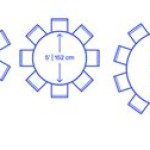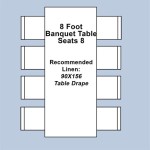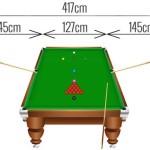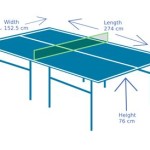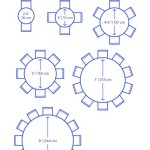Contemporary Rectangular Pedestal Dining Tables: Form, Function, and Style
Contemporary rectangular pedestal dining tables have risen in popularity as a centerpiece for modern dining spaces. They represent a departure from traditional four-legged tables, offering a clean, streamlined aesthetic and enhanced functionality. This article will explore the key features, benefits, design considerations, and materials associated with these increasingly sought-after dining tables.
Aesthetic Appeal and Space Optimization
One of the primary reasons for the popularity of contemporary rectangular pedestal dining tables is their sophisticated aesthetic. The single pedestal base, or multiple connected pedestals, eliminates the visual clutter associated with traditional legs. This creates a cleaner, more open feel in the dining area, making it appear larger and less cramped. The clean lines and minimalist design of these tables complement a variety of contemporary interior styles, from mid-century modern to minimalist and Scandinavian.
Beyond aesthetics, the pedestal base contributes to better space optimization. Traditional table legs can sometimes restrict seating arrangements and legroom. The absence of obstructive legs allows for greater flexibility in chair placement, accommodating more guests comfortably around the table. This design is particularly advantageous in smaller dining rooms or apartments where maximizing space is crucial.
The rectangular shape itself is inherently versatile. It can easily adapt to various room dimensions and layouts, fitting snugly against a wall or taking center stage in a larger open-plan living space. The clean, straight lines of the rectangle also contribute to a sense of order and formality, appropriate for a more structured dining experience.
Material Selection and Durability
The materials used in the construction of a contemporary rectangular pedestal dining table significantly impact its overall aesthetic, durability, and maintenance requirements. A wide range of materials are employed, each offering unique characteristics.
Wood: Wood remains a popular choice for dining tables, offering warmth, natural beauty, and inherent strength. Solid wood tables, crafted from hardwoods like oak, maple, or walnut, are highly durable and can last for generations with proper care. Veneered wood tables offer a more cost-effective alternative, providing the look of solid wood with a lighter weight and potentially higher resistance to warping. The finish on a wooden table can range from a natural oil finish that highlights the wood grain to a painted or lacquered finish for a more contemporary look. Wood tables are generally easy to clean with a damp cloth and require periodic polishing or oiling to maintain their luster.
Glass: Glass tabletops, often paired with a metal or wood pedestal base, offer a sleek and modern aesthetic. Tempered glass is commonly used for dining tables due to its strength and resistance to shattering. Glass tables are easy to clean and maintain, requiring only a glass cleaner and a soft cloth. However, they can be prone to scratches and fingerprints, necessitating regular cleaning.
Metal: Metal, particularly stainless steel or powder-coated steel, is often used for the pedestal base of contemporary dining tables. Metal provides durability, stability, and a modern aesthetic. Metal bases can be paired with wood, glass, or stone tabletops. Metal is generally easy to clean and maintain, requiring only a damp cloth and mild detergent.
Stone: Stone tabletops, such as marble, granite, or quartz, offer a luxurious and durable option. Stone tables are heavy and require a robust pedestal base. Each type of stone features its own unique patterns and veining, adding visual interest to the dining space. Stone tables are resistant to heat and scratches, but can be porous and susceptible to staining if not properly sealed and maintained.
Engineered Materials: Engineered materials like MDF (Medium-Density Fiberboard) or particleboard are often used in conjunction with veneers or laminates. These materials offer a more cost-effective alternative to solid wood and can be engineered to be highly durable and water-resistant. Laminate surfaces are available in a wide range of colors and patterns, allowing for greater design flexibility.
Design Considerations and Functional Features
Beyond aesthetics and materials, several design considerations contribute to the functionality and usability of a contemporary rectangular pedestal dining table.
Table Size and Seating Capacity: The size of the dining table should be carefully considered in relation to the size of the dining room. A table that is too large will overwhelm the space, while a table that is too small will not accommodate the intended number of diners. Rectangular tables generally offer more seating capacity than round or square tables of the same surface area. Standard rectangular dimensions can vary, but common sizes include those that comfortably seat four to eight people, with larger expandable models catering to larger gatherings.
Pedestal Base Design: The design of the pedestal base is crucial for stability and visual appeal. A single, centrally located pedestal base can create a minimalist aesthetic, but may require a wider footprint to ensure stability, especially for larger tabletops. Multiple connected pedestals can distribute the weight more evenly and provide a more substantial look. The shape of the pedestal base can also vary, from cylindrical to square to more sculptural forms, allowing for customization to suit different design preferences.
Expandability: Many contemporary rectangular pedestal dining tables feature expandable designs, allowing them to accommodate more guests when needed. These tables typically incorporate leaves that can be added or removed to extend the length of the tabletop. Self-storing leaves are a convenient feature that eliminates the need for separate storage. Expandable tables offer flexibility and adaptability, making them ideal for both everyday use and special occasions.
Edge Profile: The edge profile of the tabletop can impact both the aesthetics and the comfort of the table. A beveled edge offers a softer, more refined look, while a straight edge provides a more modern and minimalist aesthetic. Rounded edges can be more comfortable for diners, especially for those who tend to lean on the table or have children. The edge profile should be carefully considered in relation to the overall design of the dining room and the desired level of formality.
Table Height: Standard dining table height is typically around 30 inches. This height is comfortable for most adults to sit and eat at. The height of the chairs should be chosen to complement the table height, allowing for adequate legroom and comfortable arm positioning. Adjustable height tables are also available, providing even greater flexibility and adaptability.
Surface Finish and Protection: The surface finish of the tabletop significantly impacts its durability and ease of maintenance. A durable finish will protect the table from scratches, stains, and water damage. Common finishes include lacquer, polyurethane, oil-based finishes, and specialized coatings for stone and glass. Regular cleaning and maintenance are essential to preserve the surface finish and extend the lifespan of the table. Using placemats and coasters can help to protect the tabletop from spills and heat damage.
Integration with Other Furnishings: A contemporary rectangular pedestal dining table should be chosen to complement the other furnishings in the dining room or open-plan living space. Consider the style, color, and materials of the chairs, sideboard, lighting fixtures, and other decorative elements. Creating a cohesive and harmonious design will enhance the overall aesthetic of the space. Contrast can also be used effectively, for example, pairing a sleek glass and metal table with more rustic wooden chairs to create a visually interesting and balanced look.
Weight and Stability: The weight and stability of the dining table are crucial for safety and functionality. A heavy tabletop and a sturdy pedestal base will prevent the table from wobbling or tipping over. Consider the weight capacity of the table, especially if you plan to place heavy items on it, such as serving dishes or decorative objects. Ensure that the pedestal base is properly secured to the tabletop and that all screws and hardware are tightened regularly.
In summary, contemporary rectangular pedestal dining tables offer a compelling combination of aesthetic appeal, space optimization, and functional features. Careful consideration of materials, design elements, and integration with existing furnishings is essential to selecting the perfect table for a modern dining space.

Rectangular Black Single Pedestal Dining Table For Affordable Home Furniture Decor Outdoors And More

Brycemoor Rectangle Dining Table With Extension Ethan Allen

Rectangular Pedestal Dining Room Table Marble Decor

51 Pedestal Dining Tables That Offer Maximum Style And Chair Space

Coaster Rectangular Pedestal Contemporary Wood Dining Table In White Bushfurniturecollection Com

Chintaly Rebeca Contemporary Rectangular Glass Dining Table W Steel Pedestal Base Dt Rct

Rectangle Pedestal Tables Foter Oak Dining Table Kitchen Wood

Tyler Modern Classic Black Pedestal Rectangular Dining Table 95 25 W

Modern 63 Marble Rectangular Pedestal Dining Table Pu Leather Stainless Steel In Gold Wehomz

Coaster Rectangular Pedestal Contemporary Wood Dining Table In White Bushfurniturecollection Com

